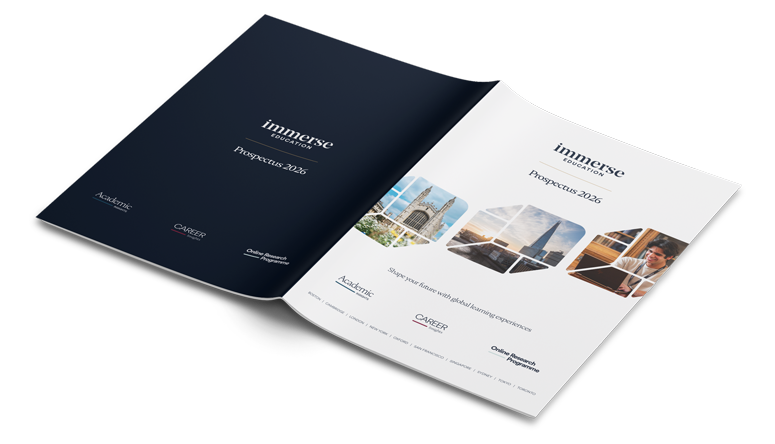Wondering what is a research paper and why it’s such a key part of academic life? A research paper or essay is a detailed, structured document where you explore a specific topic through investigation, analysis, and discussion. It offers new insights or perspectives based on evidence, whether you’re a student in high school or college, or someone contributing to scholarly conversation.
This overview explains the research paper definition, its key features, structure, purposes, and the common types you may encounter. By understanding these elements, you’ll be ready to approach your research assignments with confidence and clarity.
For more practical guidance on crafting quality research papers, check out Immerse Education’s detailed guide on how to write a research paper or explore project ideas at 100 ideas for research projects. The Immerse Online Research Programme (ORP) also offers expert mentorship for students eager to produce university-level research. If you’re curious about their structure and contents in general, though, keep on reading!
What Is a Research Paper? General Information
A research paper is an academic paper that involves:
- Choosing a focused topic or question.
- Gathering information from credible sources.
- Presenting evidence-based analysis.
- Offering interpretations, arguments, and conclusions.
Unlike personal essays or simple reports, research demands critical thinking and a systematic approach to presenting information. It usually tackles an original question or builds upon existing knowledge to reveal new understandings.
Research essays are similar but tend to be shorter and may emphasise argumentation more than original research. Still, the key goal is always to inform or persuade with clarity and evidence.
Research Paper Definition Summarised
A research paper is a scholarly work meant to:
- Investigate a specific problem or question.
- Review relevant literature.
- Employ appropriate methodology to collect and analyse data.
- Draw conclusions supported by evidence.
- Communicate findings clearly to an academic audience.
When Is a Research Paper Not a Research Paper?
It’s easy to confuse research papers with other kinds of academic writing, but not every assignment that involves “research” actually qualifies. For example, a book report, reflective essay, or summary may require you to gather information, but they don’t involve the kind of sustained inquiry and analysis that defines true research. Similarly, a lab report presents data from a single experiment but often follows a different structure and purpose than a full research paper, which situates findings within a broader scholarly context.
Another common mix‑up happens with opinion essays. While you may draw on outside sources, if the writing focuses mainly on personal viewpoints without systematically engaging with evidence or scholarship, it’s not a research paper. Even shorter discussion posts or annotated bibliographies – valuable exercises in their own right – do not stand as research papers because they lack the extended argument, synthesis, and contribution to knowledge that a proper paper requires.
Understanding what isn’t a research paper is just as important as knowing what is. If the piece doesn’t investigate a clear research question, engage with sources in depth, and present new insights supported by evidence, then it belongs to a different category of academic writing.
Join the Immerse Education 2025 Essay Competition
Follow the instructions to write and submit your best essay for a chance to be awarded a 100% scholarship.

Requirements and Structure of a Research Paper
Purpose of a Research Paper
The fundamental purpose is to contribute to knowledge on a topic by systematically finding, analysing, and presenting information. It aims to:
- Answer a research question or test a hypothesis.
- Explain complex issues or phenomena in depth.
- Demonstrate your ability to think critically and communicate effectively.
- Provide evidence-based conclusions or solutions.
Research Paper Components and Length
Most research papers contain the following sections, and in the sciences and social sciences the IMRaD format is especially common. IMRaD stands for Introduction, Methods, Results, and Discussion. It’s a highly standardised structure that ensures clarity and consistency across disciplines where concise communication is essential.
- Introduction: Sets out the problem or research question, explains its significance, and situates the study in existing literature. This is where you explain what you investigated and why it matters.
- Methods: Describes how the research was conducted—your design, data collection, and analysis—so readers can evaluate validity or replicate the study.
- Results: Presents the findings clearly, often with data, figures, or tables. Importantly, results are reported without interpretation at this stage.
- Discussion: Interprets the findings, connects them to the wider field, explores implications, and notes limitations or future research directions.
The IMRaD model has become dominant since the mid‑20th century because it mirrors the natural flow of scientific inquiry: identifying a problem, explaining how you studied it, showing what you found, and then considering what it means. While humanities papers often follow a more essay‑style structure, anyone learning how to write an abstract for a research paper in the sciences will almost always be working within this IMRaD framework. Learn more about IMRaD and get tips for each section here.
If you’re working on a longer research paper, perhaps for your EPQ, dissertations or advanced projects), the following expanded structure might be helpful:
| Section | Purpose |
| Title | Clear, concise description of your topic |
| Abstract | A brief summary outlining the aim, methods, results, and conclusions |
| Introduction | Introduces topic, research question, relevance, and thesis |
| Literature Review | Discusses existing research and identifies gaps your paper fills |
| Methodology | Details research methods, data collection, and analysis procedures |
| Results | Presents findings without interpretation |
| Discussion | Interprets results, contextualises findings, explores implications |
| Conclusion | Summarises key points, research significance, and future directions |
| References | Lists all sources cited, following academic citation styles |
| Appendices | Optional: additional details, raw data, questionnaires |
The structure enhances clarity, making it easy for readers to follow your work’s logic and assess its validity.
Types of Research Papers
When students first ask what is a research paper, it quickly becomes clear that there isn’t just one form. Research papers can vary widely depending on the discipline, the purpose of the assignment, and the level of study. Understanding the different types helps you decide how to structure your work and, just as importantly, how to frame your abstract so that it reflects the kind of study you’ve written.
Academic Research Paper
The academic research paper is the most traditional format and often the answer people think of first. These are formal, detailed works produced at high school, undergraduate, and graduate levels, and they form the backbone of scholarly communication. Academic research papers typically include a thorough literature review, a clear methodology, and evidence‑based conclusions.
Because they emphasise objectivity, critical analysis, and rigorous citation, academic research papers are usually structured in a consistent way. In the sciences and social sciences, they often follow the IMRaD format (Introduction, Methods, Results, and Discussion), which allows researchers across the world to read and understand them efficiently. In the humanities, the format may be more flexible, but the principles of clarity, evidence, and contribution to knowledge remain central.
Research Essay
A research essay is another common form, and it highlights why asking what is a research paper requires a nuanced answer. Unlike experimental or data‑driven papers, a research essay focuses more on building an argument around a thesis. It integrates evidence from secondary sources to support interpretation and persuasion rather than to report new data.
Because of this, the structure of a research essay can be more flexible, often resembling a standard essay with an introduction, body paragraphs, and a conclusion. Still, it requires the same academic discipline: careful reading, credible sources, and accurate referencing.
Other Types of Research Papers
Beyond these broad categories, there are several other specialised formats.
- Analytical: Explore complex topics by considering multiple perspectives and relationships between ideas, aiming for balance rather than persuasion.
- Argumentative: Take a clear position on a debated issue, using evidence to defend one side while engaging with counterarguments. These are particularly common in fields like political science or philosophy.
- Experimental: Present original research, often in the form of laboratory or field studies, including detailed methods, data, and conclusions. These are central to disciplines such as psychology, biology, and engineering.
- Review Papers: Synthesise and evaluate existing studies on a specific topic. Instead of offering new findings, they clarify the current state of knowledge and highlight future research directions.
Each type of research paper has its own conventions, but they all share a commitment to investigation, evidence, and clarity. Recognising the distinctions helps students and researchers approach their writing with confidence, choosing the right form for their subject and purpose.
Conclusion
Understanding what is a research paper sets the foundation for academic success. At its core, its a structured inquiry that investigates a specific question, analyses evidence, and contributes to scholarly discussions with well-supported conclusions.
Equipped with this knowledge, your journey into writing, revising, and perfecting research papers becomes more manageable. Remember, programs like Immerse Education’s Online Research Programme (ORP) are available to guide you through creating original, university-standard research, offering both mentorship and opportunities to earn UCAS points or college credits.
Explore more about publishing your research paper and browse 100 research project ideas to fuel your next project.


























